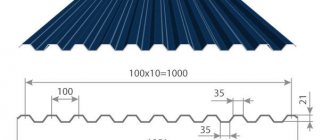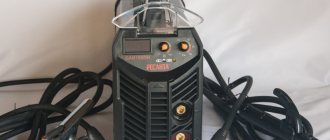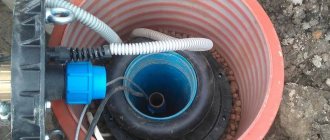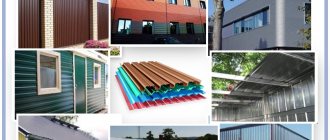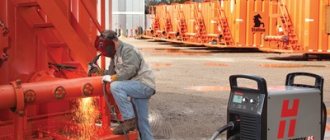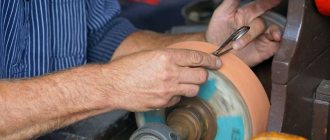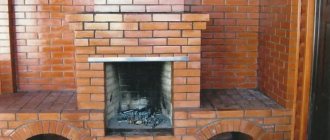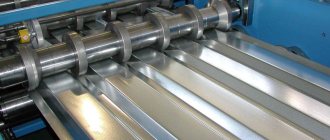Application and features
Corrugated sheeting is a metal (usually steel) sheet on which a longitudinal profile of rectangular, trapezoidal or wavy shape is formed by cold rolling, and has a protective coating. Thanks to the extruded ribs, the material will acquire high longitudinal rigidity and strength, and the coating provides resistance to weathering.
Corrugated sheeting is used in construction as walls of utility and industrial buildings, for the construction of fences and various fences, as permanent formwork for foundations, as well as for the construction of auxiliary structures and temporary floors. Particularly noteworthy is the use of profiled sheets for covering single-pitched, gable, and hipped roofs. Lightweight sheets are used as roofing material, but have increased load-bearing capacity due to the height of the profile. It should exceed 20–21 mm. Roofing corrugated sheeting is used for arranging the roofs of country and country houses, outbuildings and garages, verandas, gazebos, temporary buildings of various types, as well as for creating canopies. It can be used at different slope angles, but with the fulfillment of an important condition: the lower the slope, the higher the profile height.
Important! The dependence of the amount of overlap of sheets on the steepness of the roof must be taken into account.
Sheet types
There are three types of material : for walls, roofing or load-bearing corrugated sheeting. Consider a roofing sheet. This metal profile must meet many requirements, withstand a load of up to 5 kilograms (sometimes up to 10 per square meter, especially in snowy areas), not succumb to destructive atmospheric factors, but at the same time be very light so as not to overstress the load-bearing columns. The brands that best meet these requirements are: s-20, s-21, PK 57, s-8 and pm-35.
Profiled sheet s8
Series "C" has a fairly wide range of applications. Sheets of this brand are used to cover not only roofs, but also fences, and greenhouses are made from it. Like other types of coating, roofing sheets are produced by cold rolling and galvanizing steel with different carbon saturation levels on the bmy-1025-25 production line. Special rolling machines can also be used for this. Thanks to this, the roof can have any shape (square, trapezoid or rectangle). Main characteristics of this brand of corrugated sheeting:
- Light weight;
- Lack of stiffeners (this factor must be taken into account when constructing the frame);
- High anti-corrosion performance;
- Simplicity of installation (all brands of not only roofing corrugated sheets, but also other types have this).
Another advantage why roofing made from profiled sheets is beneficial is the wide range of color selection.
PK20 and PS20 corrugated sheets
When using C series corrugated sheets, you need to be prepared for the fact that additional processing of the painted sheet is necessary. The laying technology is the same as for all other sheets: using self-tapping screws with washers or rivets.
Video: MP20 corrugated sheet and its production
The highest price for corrugated sheets is N57-750, this is the most durable type of those listed above; a special GOST and TU were created for it, to which the rest of the profile sheets are compared (N 35-N75, NS 25, N75 and NS35).
Profiled sheet N57
Advantages and disadvantages
Profiled sheeting has the following advantages:
- Simplicity and ease of installation. The sheets are large in size and can be easily lifted to the top without the use of lifting mechanisms. You can install the roof with your own hands, without any special skills. Corrugated sheeting is cut and drilled with conventional tools. Standard fasteners are used.
- High longitudinal mechanical strength. It is provided by profiles that act as stiffeners.
- Versatility. The same sheets can be used for roofing, walls, fences, etc. Roofs of various types, configurations and slopes can be covered with corrugated sheeting.
- High resistance to atmospheric influences. Resistant to solar ultraviolet radiation, snow and wind loads. The coating reliably protects the metal from corrosion.
- Durability. When all installation requirements are taken into account, the service life of corrugated sheets exceeds 40 years.
- Reliable protection of structures from leakage. This is facilitated by the tight abutment of the sheets and overlapping installation.
- Environmental friendliness. In the manufacture of corrugated sheets, components capable of producing harmful emissions are not used.
- Fire safety. It is ensured by the non-flammability of the materials used.
- Ease. The specific gravity of corrugated sheeting is in the range of 5–9 kg per 1 m2.
- Attractive appearance. This is facilitated by a wide selection of materials in color and profile shape.
- Affordable prices. Corrugated sheeting is much cheaper than many roofing materials, and ease of installation reduces construction costs.
It is necessary to take into account the presence of certain disadvantages of the material:
- Noisy. During rain and wind, the noise level increases significantly. This circumstance requires the installation of reliable sound insulation when used for roofing residential buildings.
- High thermal conductivity. It is caused by a metal base. In summer, such a roof gets very hot, and in winter it causes a large loss of heat. Residential buildings require reliable thermal insulation.
- Condensate. Condensation accumulates on the inner surface of the roof, which requires the installation of a vapor barrier.
- Electrostaticity. Metal tends to accumulate an electrical charge, and to eliminate it, a reliable grounding (lightning rod) is necessary.
- Increased waste when covering roofs of complex shapes. It increases due to the need to cut large sheets.
- Active corrosion of the base when the protective coating is damaged. This danger occurs at cuts and places where fasteners are installed. When cutting corrugated sheets, you cannot use a grinder and welding machines, because... they can damage the coating with sparks.
In general, the advantages of the material are noticeably predominant. With proper installation and use of sound, heat, hydro and vapor barriers, disadvantages are reduced to a minimum.
Areas of application of the C21 brand
Despite the “wall” marking, the dimensions of the C21 corrugated sheet allow it to be used to solve various construction problems. The most popular of them:
- creating roofs on flat and sloping roofs, including residential and industrial buildings;
- reconstruction of outdated external walls by covering them with C21 sheets;
- construction of fences for country houses, private houses and industrial areas, including temporary fencing;
- construction of economic and industrial buildings;
- creation of rigid partitions with the possibility of insulation;
- construction of sandwich panels;
- the use of sheets of small and medium thickness to create cladding with insulation;
- construction of garages, pavilions and trade stalls.
An example of a stationary sales kiosk made from corrugated sheetsSource mod-b.ru
Types of corrugated sheets
Corrugated sheeting is divided into the following main types:
- Roofing or load-bearing type. The sheets are designated by the index H. They have increased strength and a reliable protective coating. It has an increased thickness of the metal sheet (1–1.2 mm) and profile height (more than 21 mm). An additional groove can be made in the center of the sheet to increase rigidity. It is this type of corrugated sheeting that is usually used for roofing.
- Wall type. It is designated by the letter C. It has less strength and is intended for walls, partitions, and fences. It uses a sheet of small thickness (no more than 0.7–0.8 mm), and the profile is made with a reduced height (less than 18 mm). It is not suitable for roofing, because... cannot withstand snow loads.
- Load-bearing wall or universal corrugated sheeting. Designated as NS. It is an intermediate option between the two above varieties. It is distinguished by fairly high strength, which makes it possible to use it for some roofs. For this variety, a steel sheet with a thickness of 0.81 mm is used. At the same time, the cost of the material is lower than that of N corrugated sheets. Most often, such sheets are used for the construction of fences and gates.
- Metal-polymer corrugated sheeting (MP). This is a combination of steel sheet and polycarbonate. It has good decorative properties, but is inferior to roofing sheets in strength. It is quite suitable for covering the roof area above the attic, when the transparent layer provides illumination inside the attic space. Each type of material has its own specific capabilities, which is reflected in the technical characteristics and cost.
What you need to know if you do it yourself
What to cut
The material can be cut perfectly with ordinary metal scissors, an electric or manual jigsaw, a hacksaw, or a grinder.
In the case of the latter, the cut will be rougher. And you should be extremely careful in your work; we strongly recommend that you at least skim the following text diagonally >>>
Hole Punching Tool
You can always hack something with a hammer and improvised tools. But anyone who has held a specialized tool in their hands at least once is unlikely to refuse it. We bring to your attention special pliers that punch holes Ø 10.5 mm in sheets up to 1.2 mm thick for ventilation brackets, drainage, etc.
This easy-to-use tool makes installation easy thanks to its opening width and adjustable grip depth. Typically, pliers have a set of replaceable punches.
Seals for profiled sheets
They are made from wood-polymer composite, polyethylene foam and polyurethane foam. They copy the wave of the leaf and prevent moisture, dust and insects from getting into the cracks.
Since the seal has a porous structure, it does not interfere with air circulation and the removal of moisture from under the roof, as well as the settling of condensation from below the covering.
There are different types of seals:
- self-adhesive universal (soft) – suitable for all types of products with a wave of up to 20 mm;
- special types used for this type of sheet.
Self-tapping screws
To attach the sheets to the sheathing, use a pneumatic or electric drill. The self-tapping screws are tightened observing the tightening torque. Their average consumption for installation of flooring is 5 – 6 pcs/m2.
We provided comprehensive information about self-tapping screws for all occasions, including roofing ones. Find out more >>>
Rivets
As can be seen from the comparative picture, fastening with rivets using a construction gun looks more aesthetically pleasing.
The flooring is fastened with special rivets for these products, since the use of other rivets leads to poor-quality fastening and shortens the service life.
The diameter of the rivets (3.2 - 6.5 mm) is selected according to the thickness of the sheet. This fastener is made from special aluminum and galvanized steel.
For structures made of profiled sheets, where design is important, colored fasteners can be used.
Classification by protective coating
Depending on the material of the protective coating, the following types of corrugated sheets are distinguished:
- Polyester coated (PE). The surface of the sheets can be glossy or matte, and the layer thickness is 20 and 35 microns, respectively. The polymer is capable of operating at temperatures from -30 to +80 °C. An important advantage is high strength, reduced cost and variety of colors. The disadvantage is gradual fading under the sun, but the color fades evenly. The service life of the coating is approximately 25–30 years.
- With pural (Pural, PUR). The polymer is based on polyurethane, which provides high mechanical strength and resistance to aggressive influences. The service life exceeds 30 years and the color remains virtually unchanged. Disadvantage: increased cost. Layer thickness - 50 microns.
- Coated with plastisol (PVC). The polymer is made on the basis of PVC. Coating thickness - 0.2 mm. This is the cheapest, but quite reliable option. It is characterized by high elasticity and a variety of colors. Service life is 20–25 years.
- Coated with polydifluorionade (PVF2, PVDF). This is an innovative material designed for use in particularly severe climatic conditions under significant mechanical loads. This coating is the most durable. Has a service life of more than 40 years. The disadvantage is the high price.
Some manufacturers offer corrugated sheets with a proprietary coating. Their polymer has a special composition, which is kept secret. Choosing a coating is an important step. The service life of the entire sheet and the appearance of the roof depend on its quality and reliability. At the same time, the main characteristics are directly related to the price, and therefore you have to find the best option.
Length of overlap of corrugated sheeting on the roof
The side edges of the profiled sheets should touch one or two waves, depending on the strength of the supporting structure of the roof and the expected load on the material.
An overlap of two waves is required in case of a small slope of the roof slope. This contact of the sheets will ensure the tightness and reliability of the roofing.
Horizontally, the sheets are laid with an overlap in one or two waves, vertically - 20 cm
The amount of overlap in centimeters is determined based on the degree of roof slope.
- When the roof is inclined less than 15 degrees, one edge of the sheet is overlapped by 20 cm over the other.
- If the roof slope is steeper (up to 30 degrees), then the corrugated sheeting is attached to the sheathing, making overlaps of 15–20 cm.
- With a roof slope of 35–50 degrees, contact of the edges of the sheets by 10–15 cm will be sufficient.
If it is necessary to make a horizontal overlap, stop at 20 centimeters. The resulting seams must be sealed using silicone sealant or bitumen mastic.
Marking of corrugated sheets
The brand of corrugated sheet includes a set of letters and numbers that provide information about its purpose, structure and basic parameters. Using this designation you can select the material. For example, corrugated sheet H32R-1000-0.5 is offered. The brand is deciphered as follows:
- the first letter indicates the type of corrugated sheeting: C - wall, N - roofing, load-bearing, NS - universal;
- numbers after the first letter - profile height (in the example - 32 mm);
- the letter R marks the presence of a capillary groove;
- the numbers after the dash are the useful width of the sheet excluding overlap (in the example - 1000 mm);
- the last numbers are the thickness of the steel sheet (in the example - 0.5 mm).
Now about the numbers
Brands of corrugated roofing are determined not only by their preferred purpose, which can be recognized from the letter designation
When choosing a material, you should pay attention to other characteristics. All of them can be found out by looking at the numbers in the markings of corrugated sheets
And there can be quite a lot of them there.
The grades of corrugated sheets can be determined by the digital designations in the code as follows:
- The first number in the marking indicates the height of the wave or profile. The resistance of corrugated sheets to mechanical stress largely depends on this parameter. This value is indicated in millimeters;
- Further in the marking there is a description of such characteristics as the useful width of the sheet. During production, blanks of the same width are used. But, since each brand of corrugated sheet has a different wave height, the usable width is noticeably different. It should be remembered that the material is laid on the roof with an overlap. Therefore, the useful width will be less than the physical dimensions of the corrugated sheet. This nuance should be taken into account during transportation and storage;
- The next number in the marking indicates the thickness of the sheet used in the production of corrugated board. This parameter, like the previous one, is indicated in millimeters. The strength and durability of the material being described depends on the thickness of the sheet;
- the last digit indicates the length of the profiled sheet. But this parameter may not be specified. The fact is that when ordering a certain brand of corrugated sheeting, you can specify the desired length. The manufacturer will trim depending on your wishes. But often the price lists indicate the maximum possible length. For most manufacturers it is 12,000 millimeters.
Most of the listed parameters have their own limit values. Marking of corrugated roofing sheets, for example, cannot indicate a sheet length of more than 12 meters. Thickness also has such limits. This parameter ranges from 0.4 to 1.2 millimeters. The thinnest will be profiled sheets with the letter “C”, and the thickest material is load-bearing or bearing the designation “H”.
For roofing work, it is very important to choose a profiled sheet according to the wave height. This parameter determines not only the strength, but also the reliability of the fit to the sheathing under the corrugated sheet.
As a rule, for roof covering work, a profiled sheet with a wave height of at least 18 mm is chosen, while there is no upper limit, but most often this parameter does not exceed 60-70 mm.
Also, the color characteristics may be indicated in the marking of corrugated sheets. But not all manufacturers have such an indicator in the designation. If the material has a polymer coating, then its color number is also indicated in the marking.
Specifications
When choosing corrugated roofing, you need to pay special attention to some technical parameters. The main ones are described in detail below.
Size
The length of the sheets can range from 50 cm to 14 m. The longer the sheet, the fewer sheets need to be installed, which speeds up construction. However, it is necessary to take into account the weight of the material and the length of the slope. The best option is to cover the entire slope with one sheet without cutting. In addition, long sheets are difficult to transport, and therefore corrugated sheets longer than 10 m are supplied only by special order. In private construction, the most popular length is 5–6 m. When choosing the width of the sheet, it must be taken into account that installation is carried out with an overlap of 4–10 cm. Taking this into account, the mark indicates only the useful width, i.e. sheet width minus overlap. The material must be selected according to the width of the slope so as to place a whole number of sheets on it (without cutting). Standard width of corrugated sheeting: useful - 1000 mm, total - 1051 mm.
Manufacturers can produce sheets of different widths.
An important parameter is the thickness of the steel sheet. It determines the load-bearing capacity, strength and reliability, but the weight also increases with increasing thickness. Standard thicknesses are 0.4, 0.45, 0.5, 0.55, 0.6, 0.7 and 0.8 mm. You can order corrugated sheets with a sheet of 1–1.2 mm. Most often, a thickness of 0.45–0.5 mm is recommended for roofing, but in regions with heavy snowfalls it should be increased as much as possible.
Weight
It increases with increasing thickness of the steel sheet. With a thickness of 0.5 mm, the weight is 5.14 kg, with 0.7 mm - 7.13 kg and with 0.8 mm - 8.11 kg/1 m2. The optimal weight is considered to be in the range of 4.5–5.5 kg/m2.
Life time
Durability depends on the presence and type of protective coating, as well as on production technology. The cheapest unprotected corrugated sheeting made of galvanized steel has a service life of no more than 12–15 years. Budget coverage options increase it to 25 years. The most reliable PVDF coating provides a durability of 40 years, and in reality the roof can last more than 50 years.
Color
The appearance of corrugated roofing provides a variety of color solutions. The most popular colors are brown, burgundy, green and blue in different shades. You can choose other tones. It is important that the color of the roof is harmoniously combined with the design of the facade of the building and the overall landscape design.
The listed criteria affect the reliability and attractiveness of the roof. The choice must be made taking into account the purpose and size of the structure, as well as specific climatic conditions.
Roofing from corrugated sheets: calculation of the number of sheets
To calculate the material for the roof, you will definitely need information about the dimensions of the material used and the roof. To begin with, it is recommended to start by calculating the rafter system.
You also definitely need information about the expected weight of the finished structure, and the cross-sectional values of the beams, taking into account the coating material.
The main components of the rafter system are logs and beams, which are intended for the construction of the roof frame. The calculation of the pitch of laying the beams is done after calculating the load on the roof, which takes into account the weight of the roof, its covering and its own weight.
This is done to provide for all possible loads on the roof. In addition, the calculation of the load includes the weight of the workers who will be installing it and strong gusts of wind.
Attention!
To calculate the covering and rafter system, use our online calculator! After calculating the total load, the number of wooden beams is calculated, which are distributed in a certain direction at angles.
Calculations:
- In order to determine what load will be optimal for a linear meter of parts of the rafter system, you need to use tables with detailed calculations that are found in specialized literature on construction.
- The total footage is calculated.
- The total number of beams is calculated by measuring the length of one of them.
What determines the durability and reliability of a roof?
The service life and reliability of the entire roof depend on the following factors:
- The correct choice of corrugated sheeting, taking into account the type, purpose and operating conditions. You should not save money and install a wall sheet on the roof, which may simply not withstand snow and wind loads.
- Compliance with all technological requirements during installation. This is, first of all, correct installation, reliable fastening and ensuring the required overlap. The height of the profile and ceiling is selected taking into account the slope angle of the slope.
- Presence of active corrosion areas. They appear when the protective coating is broken. The places where holes are drilled and cuts must be protected with special paint or spraying.
Important! The correct choice of material, compliance with the rules of installation and maintenance of the roof ensures an increased service life and reliably protects structures from precipitation.
What to consider when choosing sheets?
First of all, the thickness of the metal for the roof should be maximum. It is one of the key characteristics on which the service life and strength of the roof depend. Ideally, this is millimeter steel that effectively resists deflection. For garage construction, instead of profiled sheets, they chose simple sheet steel with a thickness of 2-3 mm, which allowed an all-steel garage to last for decades.
According to SNiP, a thickness of 0.6 mm can be chosen for private construction in an area securely fenced from strangers. In the case of multi-apartment and factory construction, 1 mm steel is used.
The height of the wave will play an important role in the strength of the roof. Although this is not a panacea for overload, for example, from a large number of people going onto the roof to service the roof, waves of 2 cm in height are a temporary solution. The fact is that a profiled sheet is more difficult to bend; its relief partially compensates for the deflection of the steel. However, an exorbitant load, for example, from a heavy worker wearing boots with very hard heels and walking carelessly on the roof, will simply crush the waves.
A sheet length of 4 m is suitable for a slope whose width is less than this length. The calculation must be made taking into account the steel ridge, each side strip of which will partially reduce the main width of the slope covered with corrugated sheets. Up to 30 cm can go under the ridge - the remainder is important in the case when the lower edge of the corrugated sheet hangs over the reinforced belt with the Mauerlat, partially protecting the walls of the house from slanting rains. For slopes up to 6 m, 6-meter sheets are suitable. For slopes with a significant width - up to 12 m - sheets of similar length are suitable; The longer the sheet, the more labor-intensive it is to install. A solution involving the installation of sheets adjusted to the width of the slope allows you to get rid of horizontal seams - the entire strip is a single whole.
Type of corrugated sheet covering
Plastic-coated corrugated sheets look promising in terms of durability. If the composition resists the negative effects of excess heat and ultraviolet radiation, and also does not crack in the cold, then such sheets will last a long time - up to 40 years.
Special attention was paid to simple roofing iron, which was “quiet steel” - simmered sheet metal, capable of serving, when the protective layer peels off, not 3-5, but up to 30 years.
Technologies and standards that allow the production of “quiet” steel turned out to be very energy-intensive. GOST standards for casting and rolling steel have changed along with technology. Steel production accelerated, and as a result its durability suffered. Taking this into account, the coating of steel structures, including corrugated sheets, is selected so that it does not fade or wear out for a long time before the load-bearing material from which the corrugated sheet itself is made is exposed. It is useful to inspect the roof once every six months to a year for peeling of the protective coating - and if you suspect looseness or fading, update it using a rust-resistant enamel primer and polymer (synthetic) paint.
The thickness of each coating layer is at least 30 microns: a thinner coating will peel off much faster, and the steel will rust a few days after the protective layer has completely peeled off. Some craftsmen use galvanized corrugated sheets, but zinc is easily corroded by acid, the residues of which (sulphurous, nitrogenous, coal) are always present in urban precipitation (rain). For the roof, zinc coating - although it is not afraid of water as such - is not used.
Companies that supply ready-made corrugated sheets for roofing work state their recommended service life is 15-40 years. The minimum service life of the roof if the roof is used carelessly - for example, falling hand tools leading to scratches of the coating, keeping forgotten and unnecessary things (especially metal) on the roof - will be reduced to just a few years. They do not undertake to guarantee a longer “life” of the profiled sheet; no matter how durable and high-quality the steel is, it cannot “live” 100 years or more.
The corrugated steel sheet, in addition to its weight, can withstand the weight of snow, people walking on the roof during its maintenance (and scheduled repairs), as well as tools laid out at the work site. The roof should be strong, capable of withstanding all these impacts at once.
Manufacturers
Consumers and experts in 2022 identify the following best manufacturers of corrugated sheets:
- GRAND LINE (Russia). The company is rapidly developing a distribution network throughout Russia. Offers corrugated sheeting of all main types. The main coating is plastisol.
- Neva Steel. The company pays special attention to the quality of raw materials. High-quality rolled steel ArcelorMittal, Corus, Zalzgitter, Ruukki is used.
- Pokroff plant. Finnish technology is used in the production of profiled sheets. The steel is supplied by Severstal. The main coating is polyester.
- Ural Roofing Materials Plant (UZKM). The products are distinguished by ideal geometry and dimensional accuracy. For coating, purol, polyester, and plastisol are used. Original models with a velvety effect are offered.
- MetalProfile. The plant is considered the largest manufacturer of corrugated sheets in the Russian Federation. PURETAN, PURMAN and other branded polymers are used for coating. A wide range of products is offered.
Important! When purchasing corrugated sheets, it is important to pay attention to the manufacturer. Only trusted companies can guarantee quality and durability.
Criteria for selecting profile sheets
When choosing which corrugated sheeting to cover the roof with, pay attention to its markings. Not only the letter or numeric index is important, but also the GOST or TU marks
They mean compliance with government regulations, which are higher than those of manufacturing companies. There are other requirements that will help buyers how to choose corrugated sheets. Experts recommend focusing on:
- Appearance of profile sheets. Inspect the products. They should not have any defects - chips, peeling, paint runs.
- Geometric proportions of roofing material. The manufacturer must match the dimensions of the corrugated sheeting needed for your roof with the products he has available. Measurements of thickness, width and length according to GOST are a sign of a high-quality profile.
- Wave proportions. The corrugated sheets are arranged with an overlap, so the upper corrugation necessarily covers the lower one. Are you wondering what type of corrugated sheeting to choose for your roof? Purchase the required 20 cm of metal to ensure a high-quality overlap and reduce the risk of moisture getting on the roofing pie.
- Sheet cutting quality. At the factory, the metal profile is cut with a guillotine. Smooth and precise edges without nicks guarantee the absence of rust.
- Strength indicators. The round samples shown by the seller will not explain the strength of the material. Ask to demonstrate square samples.
- Sealing of packaging. If the profiled sheets are properly packaged, they will not be damaged during transportation.
Be sure to ask the supplier to issue a guarantee for the product and provide certificates of conformity. This will not only demonstrate the quality of the material, but also declare the responsibility of the selling company.
Prices
The cost of corrugated sheeting depends on the thickness of the metal, coating material, production technology, manufacturer, special properties and design solutions. Service life and appearance are directly related to price, and therefore the buyer, based on his financial capabilities, chooses the optimal combination. The cheapest are sheets up to 0.5 mm thick with a profile of 20–30 and a PVC and polyester coating. The average price for them in the Russian Federation is 250–285 rubles per 1 m2. Similar products coated with pural will cost 510–560 rubles/m2.
Sheet dimensions and weight
In general, enterprises produce profiled sheets not only in accordance with GOST, but also in accordance with technical specifications. Specifications are technical conditions in which the manufacturer sets down its dimensions and quality requirements. Registering them is not that difficult. But this is not GOST and anything can be there. If you see specifications on the labeling or in the accompanying documents, it is better to read it so that there are no surprises. And the standard does not have many profiles and sizes of corrugated sheets, which is why specifications are used. Consumers demand other sizes and profiles. The table shows the grades and sizes of corrugated sheets according to GOST, and the figure also includes drawings and appearance. By the way, sheet thickness with * is not a standard.
Drawing of the profiled sheet and appearance, sheet width and thickness
| Designation of profiled sheet | Width, mm | Metal thickness, mm | Weight of 1 meter long, kg | Weight per square meter, kg |
| N-75-750-0.7 | 750 | 0,7 | 7,4 | 9,8 |
| N75-750-0.8 | 750 | 0,8 | 8,4 | 11,2 |
| H75-750-0.9 | 750 | 0,9 | 9,3 | 12,5 |
| Н114-600-0.8 | 600 | 0,8 | 8,4 | 14,0 |
| Н114-600-0.9 | 600 | 0,9 | 9,3 | 15,6 |
| N114-600-1.0 | 600 | 1,0 | 10,3 | 17,2 |
| H114-750-0.8 | 750 | 0,8 | 9,4 | 12,5 |
| H114-750-0.9 | 750 | 0,9 | 10,5 | 14,0 |
| N114-750-1.0 | 750 | 1,0 | 11,7 | 15,4 |
| NS35-100-0.6 | 1000 | 0,6 | 6,4 | 6,4 |
| NS35-100-0.7 | 1000 | 0,7 | 7,4 | 7,4 |
| NS35-100-0.8 | 1000 | 0,8 | 8,4 | 8,4 |
| NS44-1000-0.7 | 1000 | 0,7 | 8,3 | 8,3 |
| NS44-1000-0.8 | 1000 | 0,8 | 9,4 | 9,4 |
| S10-899-0.6 | 918/899 | 0,6 | 5,1 | 5,7 |
| S10-899-0.7 | 918/899 | 0,7 | 5,9 | 6,6 |
| S10-1000-0.6 | 1022/1000 | 0,6 | 5,6 | 5,6 |
| S10-1000-0.7 | 1022/1000 | 0,7 | 6,5 | 6,5 |
| S18-1000-0.6 | 1023/1000 | 0,6 | 6,4 | 6,4 |
| S18-1000-0.7 | 1023/1000 | 0,7 | 7,4 | 7,4 |
| S15-800-0.6 | 940/800 | 0,6 | 6,5 | 6,0 |
| S15-800-07 | 940/800 | 0,7 | 6,55 | 6,9 |
| S15-1000-0.6 | 1018/1000 | 0,6 | 6,4 | 6,4 |
| S15-1000-0.7 | 1018/1000 | 0,7 | 7,4 | 7,4 |
| S21-1000-0.6 | 1000 | 0,6 | 6,4 | 6,4 |
| S21-1000-0.7 | 1000 | 0,7 | 7,4 | 7,4 |
| S44-1000-0.7 | 1000 | 0,6 | 7,4 | 7,4 |
Everything seems clear in the table. The dimensions of the profiled sheet are indicated in the same way as prescribed in the standard: profile height, sheet width and metal thickness. Length - by agreement or according to the manufacturer's capabilities. Questions may be where the width is indicated through a fraction. For example, 1022/1000. The first number is the full width when covering walls, the second is the working width when installing on the roof. As you understand, this is a dual-use material. Can be used both on the roof and for wall cladding.
For comparison, look at what sizes of corrugated sheets they can offer, and compare with what GOST prescribes
It is worth saying that if the parameters of a profiled sheet do not comply with GOST, this does not mean that the material is bad. You need to look at the quality of the coating and the rigidity of the sheet. In any case, it is worth finding reviews on the products of a specific manufacturer. Because standard ones can be made not so well. It's all about the quality of steel and coatings.
Comparison with other materials
It cannot be said that in all cases corrugated roofing is most suitable. Compared to other roofing materials, it has its pros and cons. When compared with soft rolled materials, profiled sheets are noticeably inferior in heat and sound insulation abilities, but superior in strength and durability. It is much easier to cover roofs with complex shapes and slopes with steep slopes using roll materials. Compared to conventional tiles, corrugated roofing is much lighter, faster and easier to install, much cheaper, but inferior in appearance and thermal insulation properties. Regular slate corrugated sheeting is superior in design, strength, and the prices are comparable. The closest material is metal tiles. It has similar disadvantages, but is more attractive in appearance and is reinforced with transverse ribs. At the same time, it is more expensive.
Tips for choosing material
Depending on the area of application, the profiled sheet has different parameters and, accordingly, different prices, so you must first decide:
- where do you plan to use this material,
- what kind of load will he experience?
- under what conditions to operate,
- what service life do you expect?
When choosing a profiled sheet, do not underestimate the thickness of the profiled sheets; this indicator affects the service life and resistance to local loads: tearing at fastening points, resistance to deflection during hail, during installation and repair work, etc.
The thickness of the metal greatly affects the price, so in some cases it is worth focusing on the height of the profile. The height of the profile reduces the coverage area. You need to find a middle ground between the thickness of the metal and the height of the profile.
In terms of the variety of coating and choice of color, the most suitable profiled sheet is with a thickness of 0.5 mm GOST.
What else should you pay attention to?
Practice shows that in addition to the main criteria when choosing corrugated sheeting for a roof, you should pay attention to the following nuances:
- Appearance - absence of defects, peeling and unevenness of the coating.
- Leaf geometry. It should have clear lines and angles. Dimensional deviation should not exceed 0.1 mm.
- Profile geometry. In places where they overlap, the profile waves should fit tightly to each other.
- Edge quality. Notches and sagging are not allowed on cuts.
Important! When purchasing a product, you should check for manufacturer certificates and warranties. It is necessary to check the quality and integrity of the packaging.
Tips to help the buyer
Detailed familiarization with the nuances of material selection and its labeling is only part of the story. Practical recommendations from experienced roofers will help the future owner not to make a mistake in purchasing:
- Buy material for work from one supplier . Immediately calculate the consumption to purchase from one batch. So that you don’t have to search long and painfully for one sheet of corrugated tin of a similar tone and thickness.
- Purchase additional elements and fasteners together with the roofing . You can, of course, later in another store, but the shade may differ. If this was not included in the design, the effect may be completely unexpected.
- Pay attention to the integrity of the packaging . There shouldn't be any damage. It is possible that under the rupture there is already a microcrack in the polymer shell. This means that there is a possibility of a rust outbreak.
- Consider the sheets and additions . If you find the smallest scratches or abrasions, feel free to contact the seller for a replacement.
- Buy repair paint to match the corrugated coating . It will be useful during installation and after, if damage left by branches or vandals is detected. Do not buy spray paints.
It’s worth following the tips listed above if you don’t want to waste your money. If, of course, you have excess savings that you can easily part with, then you can ignore the recommendations presented.
Corrugated steel does not require any special maintenance techniques. Dust is washed off from its surface without delay during rains. The snow coming off the slopes does not leave scratches or streaks.
If persistent contamination is detected, it is recommended to wash the corrugated sheet with soapy water and wipe with a soft cloth.
